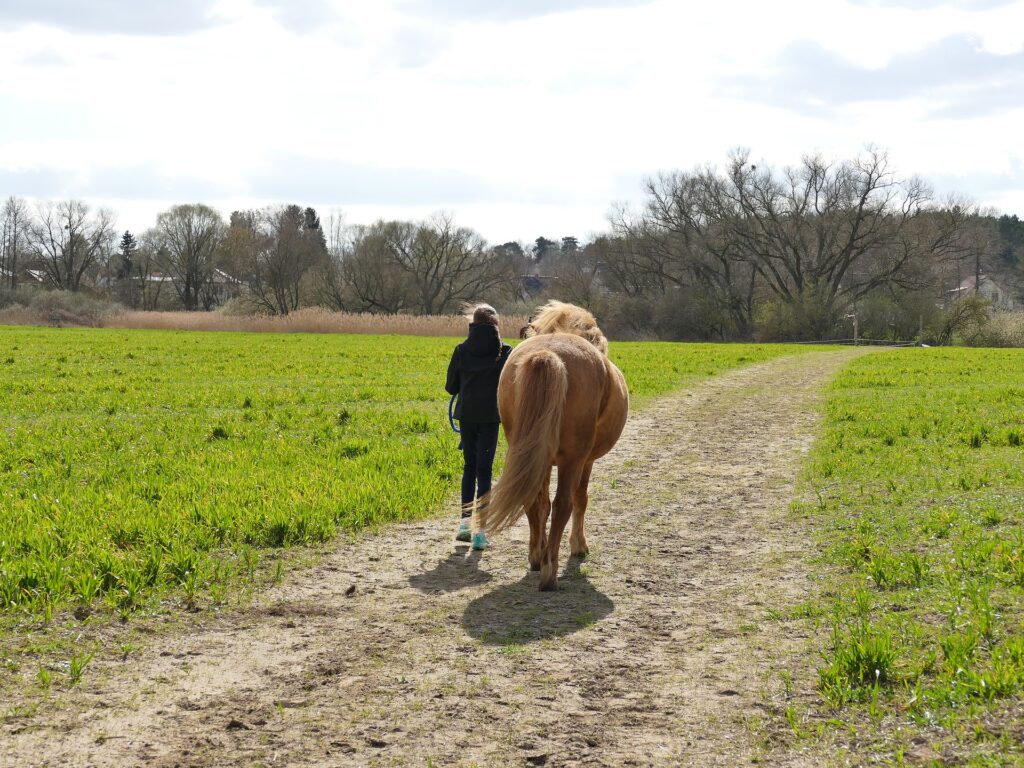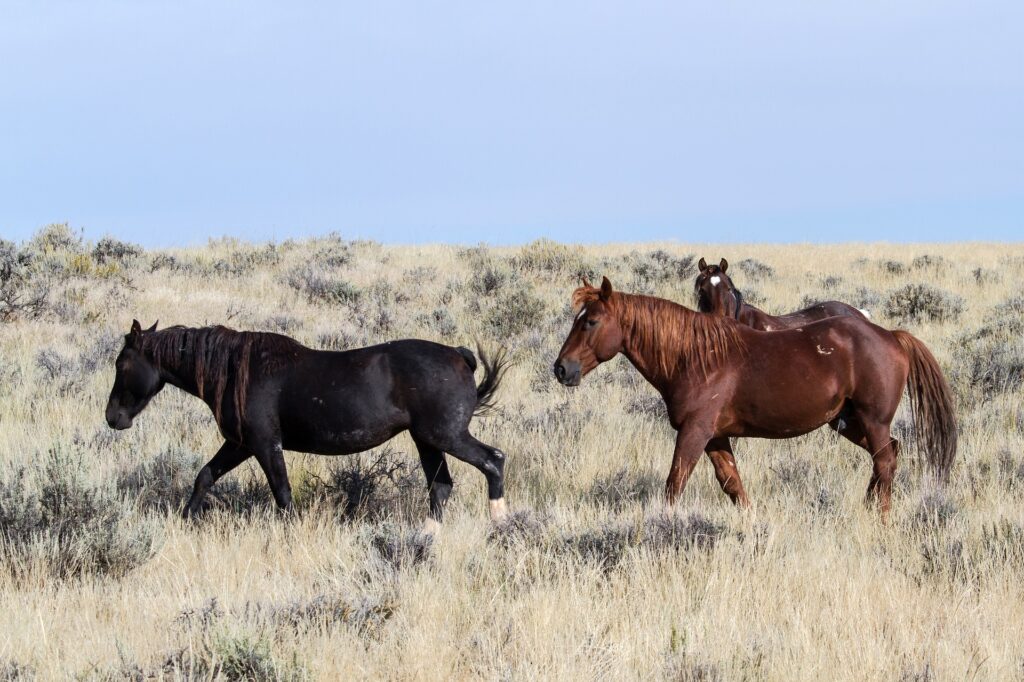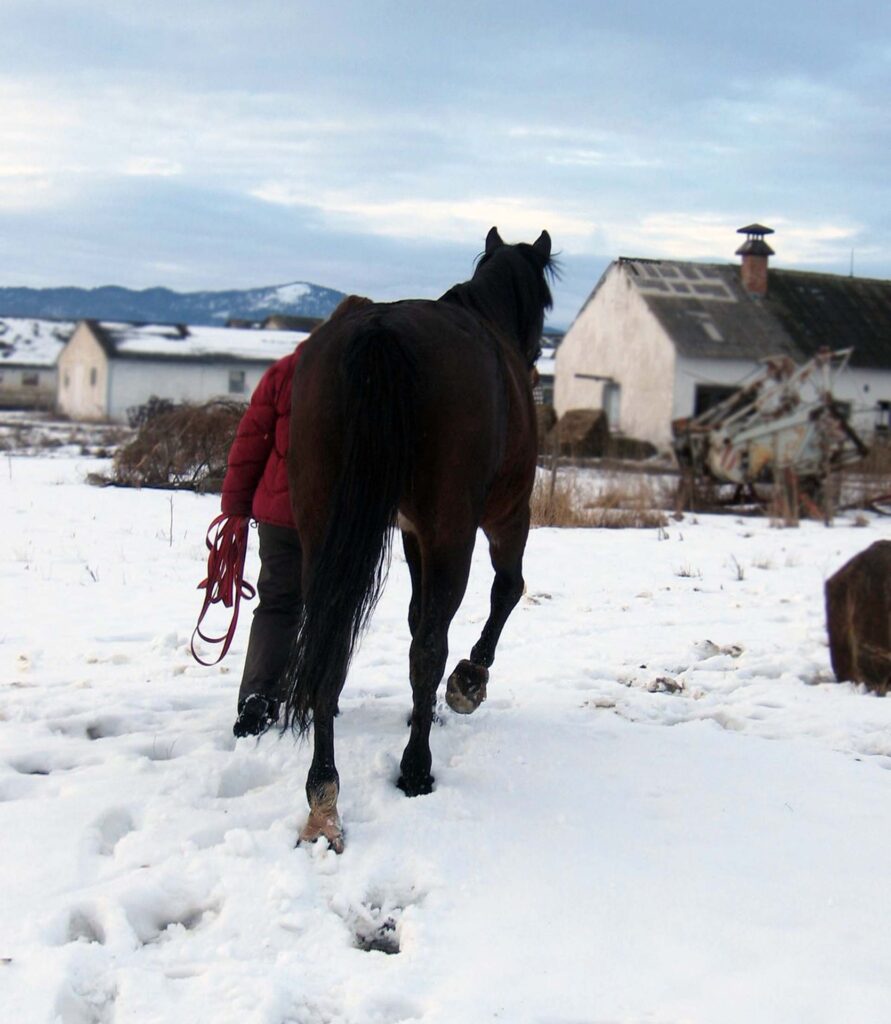
Have you ever gone for a walk with your horse?
Not just to get from barn to paddock, or to cool out after a ride. Have you taken a walk with the goal of allowing your horse to explore the world around them using their five senses? This is a sensory walk, and it’s a type of enrichment that you can easily work into your horse’s routine. Read on for the details on why this enrichment is important and how to go for an enriching sensory walk with your horse.
What is a Sensory Walk?
A sensory walk, path, or trail, is set up to stimulate your horse’s senses in a directed manner. These senses are sight, hearing, smell, taste, and touch. A sensory walk is a stroll outside the pasture where the horse can explore, and can be any duration, any distance, and with any number of special enrichment opportunities that you may or may not have set up in advance. Unlike some other enrichment activities that involve hand walking, its purpose is to encourage sensory experiences more than movement.
One of the best aspects of this enrichment is that it can be enjoyed by any equine. Horses, donkeys, and mules can all go for sensory walks and have a lovely time. Both very young and elderly animals can participate, and this enrichment is a particularly valuable one for non-ridden horses who need plenty of opportunities to get out of the paddock and enjoy a change of scenery.
Why It Works
The pasture or paddock environment is very constant and unchanging unless we work to change it – it’s a controlled environment, the horse spends most of their time there, and they know all the normal sights, sounds, and smells that it has to offer. Our horses doesn’t experience the same changing stimuli as a wild or unmanaged equine would, covering wide distances and varied terrain each day. Taking a short sensory walk can’t recreate that wild experience fully, but it can offer some of the positives (new sights and sounds! Interesting things to much on!) without some of the negatives (lions, tigers, and bears).

Image by Klaus Stebani from Pixabay
Although they’re outwardly similar, a sensory walk isn’t the same as simply hand walking your horse. Hand walking is a good form of exercise and can be used to train the horse to better focus on you, and for desensitizing the horse to scary environmental situations. During a hand walk in the traditional sense, the purpose isn’t for the horse to investigate or utilize choice and control. Depending on your training style and handling preferences, it is possible for a hand walk to be enriching and allow for natural behaviors, but it’s not the purpose of the activity. A sensory walk, on the other hand, is all about providing the opportunity for the horse to interact with the items and situations on the walk in whatever way they prefer. Choice and control, in addition to the use of the five senses, characterize this enrichment.
For this reason, the most ideal sensory walk would be one done completely at liberty, but this is not practical for many equestrians. We’ll talk more about safety later in this post, but remember to always balance realistic safety needs with your behavior priorities and keep everyone free from harm during enrichment if at all possible. When my horse and I go for sensory walks, I use a halter and lead (and my ever-present training whistle and treat pouch, of course).

How to Take a Sensory Walk
A sensory walk sounds very simple, and at its core, it is: Take your horse for a walk and allow them to experience aspects of their environment outside of their stall or pasture, exploring and investigating whatever they like. Sniff that tree! Taste that grass! Listen to that strange bird call! Feel that cool breeze! The wonderful thing about a sensory walk is that there are almost unlimited variations and possibilities.
Horses are wonderfully curious. Despite being prey animals, most horses appear to enjoy exploring and investigating new situations. The sensory walk is a general-purpose way to stimulate any of the five senses – sight, hearing, smell, taste, and touch – during the walk. This exposure to fresh stimuli mimics the array of new sights, sounds, and smells that a herd of horses would experience while moving through the environment over time.
How Long?
The length of time spent or the amount of ground you cover will vary depending on your horse’s preferences. A sensory walk can be mere minutes long or it can be an extended ramble outside the pasture. As with most enrichment activities, shorter is usually better when the horse is new to the experience. Especially for horses without much hand-walking practice, frequent shorter opportunities to explore and use their senses will keep the activity engaging and help prevent overstimulation.
Plan for a short walk the first few times – maybe no more than a five minute stroll or a simple route across the property – to see how your horse responds, what they seem most interested in, and what senses they appear to use most. From there, you can work in longer sessions and plan sensory stations to offer your horse additional enrichment.
Where? How Far?
The first few times you offer this enrichment, you might want to take a well-traveled trail or cover a path your horse knows well, especially if they are unused to traveling off the beaten path from pasture to stall.
As your horse becomes used to walking with you as enjoyable enrichment, you can go further – or, if your horse prefers, keep close to home instead. You don’t have to take the same path each time, but you can if your horse is easily overstimulated – keeping things predictable and simple can help horses like this process the activity fully.
Getting Started
On an enrichment walk, either you or your horse can lead. The horse should have enough leadline to sniff objects on either side or on the ground, and can be encouraged to go at any pace they desire. Some horses appear to want to travel during the walk, covering a lot of ground, while others only want to graze – and that’s fine. An enrichment walk can turn into a hand grazing session and back again. Some horses that have been thoroughly schooled to walk in hand may not understand the new and more relaxed rules for this activity and might be glued to your side. It may take a few sessions, possibly including setting up some “sensory stations” along your route, for these horses to exhibit more curiosity.
It’s possible to teach horses to distinguish between everyday leading from place to place and a sensory walk, so that at non-enrichment times, the horse leads appropriately. One way to do this is by keeping a dedicated halter and lead, maybe of a different texture than the usual one, for enrichment walk purposes. Horses are definitely capable of understanding the purpose behind different pieces of equipment as long as they can tell the difference between them. If you don’t use a halter or don’t want to worry about consistently using a dedicated halter for enrichment, you can accomplish the same goal by starting your sensory walk in the same place and same way each time.
Special Activities and Sensory Stations
On your first few enrichment walks, let your horse’s behavior guide the session. When you’ve gone on a few walks and want to offer more guided opportunities for the horse to use different senses, you can set up ‘sensory stations’ in advance for your horse to experience. The benefit of exploring what’s already there is that, depending on where your horse lives, there are probably many stimulating sights, scents, and sounds already present, so you don’t have to do any extra work. Even sniffing a parked vehicle or examining a puddle from recent rains is valuable sensory stimulation.

Image by Nana Cola from Pixabay
Setting up a few enriching experiences in advance, on the other hand, lets you target specific senses on any given walk. You can really let your creativity shine here. Sight, hearing, scent, taste, and touch are all senses that the horse can use on a sensory walk, and you can prearrange some opportunities for each one along the way or focus on just one sense per walk. Try hanging a wind chime in a tree along your planned route, turn over a few spadefuls of dirt alongside the trail to raise the scent of soil, or set out a pan of surprise treats for the horse to discover. There are so many possibilities; just think of one of your horse’s senses and let that guide you as you create stations every few yards along your planned route.
Keeping Safe
Walking for sensory enrichment comes with some unique safety concerns. Safety of horses and humans should always be at the front of our minds when crafting enrichment, so here are the things to consider when going for a walk:
- Keep the first few routes short and familiar so that your horse can get acquainted with the concept.
- If your horse is excitable or known to be easily startled, you can “proof” the route by walking it yourself before bringing your horse along. This way, you can identify and adjust items that might cause a spook, or make changes to your route.
- If you plan to walk off property, it’s a good idea to let someone know where you’re going, when you’re leaving, and when you expect to return. Most sensory walks are short, so a simple heads-up at the barn usually works for me.
- Stay calmly alert at all times. If you choose to use a halter and lead – which I recommend, though it is very possible to offer this enrichment at liberty – make sure to keep it safely looped just as when leading your horse normally. Ideally, allow your horse a few feet of lead so that they can adjust their position and examine objects without running into the pressure of the rope.
- If your horse becomes uncomfortable or overstimulated, don’t hesitate to return home. It’s better to take simple, short sensory walks and add them into your regular enrichment offerings.
Scheduling and Planning
Sensory walks are easy to fit into your enrichment schedule, but they do take some forethought because you’ll have to be on hand for the walk itself and any prep time needed to set up special stations along the way.
A quick walk doesn’t have to take a long time, though. Five minutes can be enough, and this should fit into anyone’s schedule. I suggest trying to plan one once a week, see what fun you and your horse get into, and then go from there. You may find that letting your horse explore the world alongside you is fantastic for your relationship and want to go out more frequently, especially as your horse gets more and more comfortable with the experience.
If you want to give your horse a really beneficial enrichment, a sensory walk outside the paddock, or even off property, really fits the bill. Each time my horse Allan and I go exploring, I feel that he has a lovely time and shows increased curiosity and confidence each time. I encourage you to pick out a path, maybe set up a few visual, scent, or auditory experiences along the way, and enjoy taking your horse out for a chance to investigate and have a really enriching time. Remember to stay safe and mindful of your horse’s needs and behavior, adjusting and refining the content and duration of the enrichment based on your horse’s needs. No matter your horse’s age or breed, the sensory walk is a simple but very enjoyable way of providing sensory stimulation. Happy enriching!